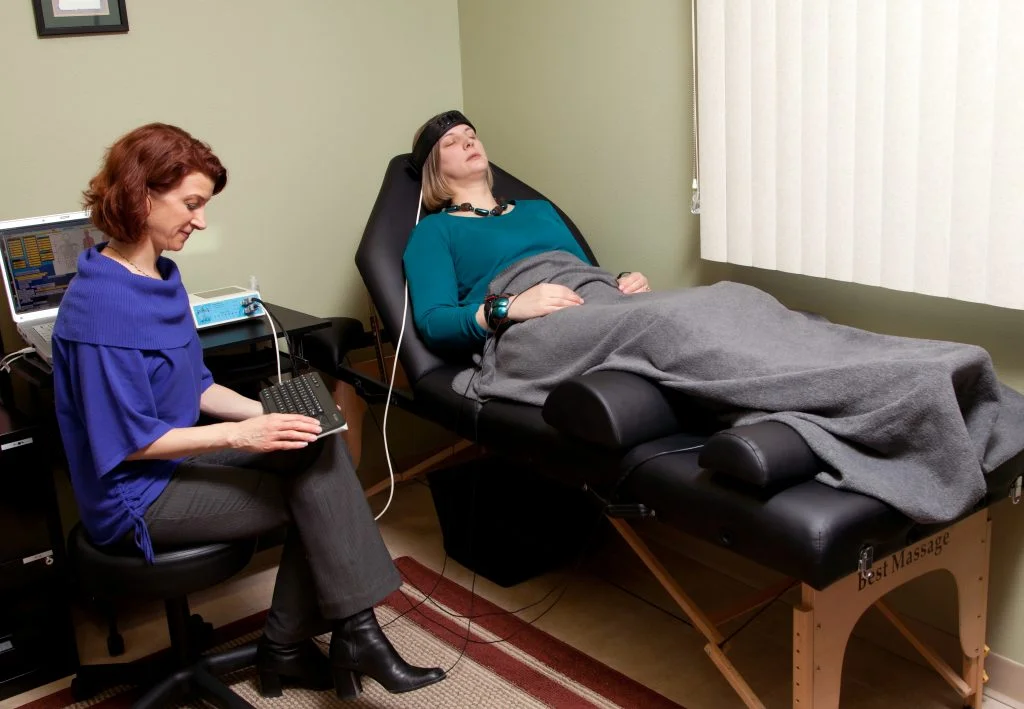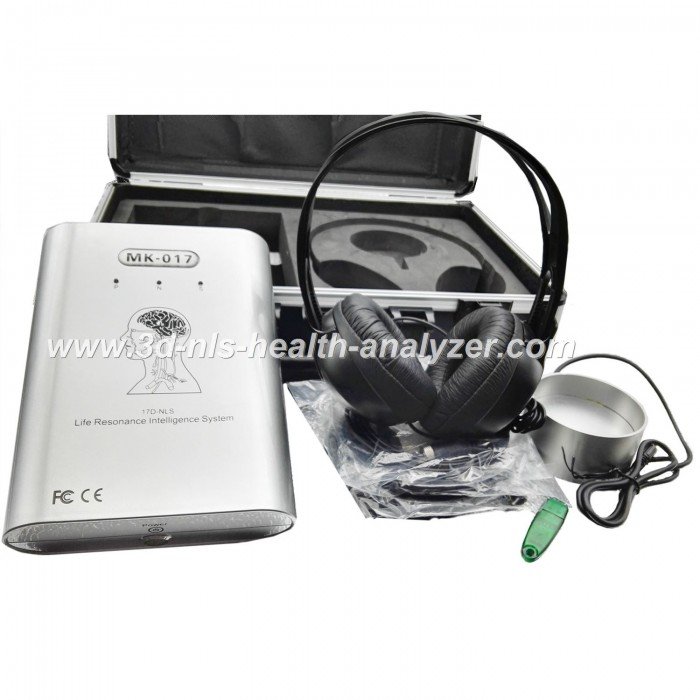quantum biofeedback therapy



What quantum biofeedback therapy?

Biofeedback is a treatment technique in which people are trained to improve their health by using conscious and subconscious signals from their own bodies.
Psychologists use it to help tense and anxious clients learn to relax. Specialists in many different fields use biofeedback to help their clients cope with pain. Both clients and practitioners use it to gauge and direct the progress of treatment. For clients, the biofeedback device allows them to “see” or “hear” activity inside their bodies.
The biofeedback trainee, in an attempt to improve a skill, monitors the performance & makes internal adjustments, which alter the signals. The biofeedback practitioner acts as a coach, standing at the sidelines setting goals and limits on what to expect and giving hints on how to improve performance.
How quantum biofeedback therapy work?
Most clients who benefit from biofeedback are trained to relax and modify their behavior. Most scientists believe that relaxation is a key component in biofeedback treatment of many disorders, particularly those brought on or made worse by stress. Their reasoning is based on what is known about the effects of stress on the body. In brief, the argument goes like this: Stressful events produce strong emotions, which arouse certain physical responses. Many of these responses are controlled by the sympathetic nervous system, the network of nerve tissues that helps prepare the body to meet emergencies by “flight or fight.”
The typical pattern of response to emergencies probably emerged during the time when all humans faced mostly physical threats. Although the “threats” we now live with are seldom physical, the body reacts as if they were: The pupils dilate to let in more light. Sweat pours out, reducing the chance of skin cuts. Blood vessels near the skin contract to reduce bleeding, while those in the brain and muscles dilate to increase the oxygen supply. The gastrointestinal tract, including the stomach and intestines, slows down to reduce the energy expensed in digestion. The heart beats faster, and blood pressure rises.
Normally, people calm down when a stressful event is over especially if they have done something to cope with it. For instance, imagine your own reactions if you’re walking down a dark street and hear someone running toward you. You get scared. Your body prepares you to ward off an attacker or run fast enough to get away. When you do escape, you gradually relax.
The word “Biofeedback” was coined in the late 1960s to describe laboratory procedures then being used to train experimental research subjects to alter brain activity, blood pressure, heart rate, and other bodily functions that normally are not controlled voluntarily.
At the time, many scientists looked forward to the day when biofeedback would give us a major degree of control over our bodies. They thought, for instance, that we might be able to “will” ourselves to be more creative by changing the patterns of our brain waves. Research has demonstrated that biofeedback can help in the treatment of many diseases and painful conditions. It has shown that we have more control over so-called involuntary bodily function than we once thought possible. But it has also shown that nature limits the extent of such control. Scientists are now trying to determine just how much voluntary control we can exert.

The history of Biofeedback
Clients usually are taught some form of relaxation exercise. Some learn to identify the circumstances that trigger their symptoms. They may also be taught how to avoid or cope with these stressful events. Most are encouraged to change their habits, and some are trained in special techniques for gaining such self-control.
Biofeedback cannot cure disease or by itself make a person healthy. It is a tool, one of many available to health care professionals. It reminds physicians that behavior, thoughts, and feelings profoundly influence physical health. Biofeedback helps both clients and doctors understand that they must work together as a team.
How is Biofeedback being used today?
Biofeedback places unusual demands on clients. They must examine their day-to-day lives to learn if they may be contributing to their own distress. They must recognize that they can, by their own efforts, remedy some physical ailments. They must commit themselves to practicing biofeedback or relaxation exercises every day. They must change bad habits, even ease up on some good ones. Most important, they must accept much of the responsibility for maintaining their own health.
Your responsibilities
Quantum Biofeedback
If you get angry with your boss, it’s a different matter. Your body may prepare to fight. But since you want to keep your job, you try to ignore the angry feelings. Similarly, if on the way home you get stuck in traffic, there’s nothing you can do to get away. These situations can literally make you sick. Your body is prepared for action, but you cannot act.
Individuals differ in the way they respond to stress. In some, one function, such as blood pressure, becomes more active while others remain normal. Many experts believe that these individual physical responses to stress can become habitual. When the body is repeatedly aroused, one or more functions may become permanently overactive. Actual damage to bodily tissues may eventually result.
Biofeedback is often aimed at changing habitual reactions to stress that can cause pain or disease. Many clinicians believe that some of their clients have forgotten how to relax. Feedback of physical responses such as skin temperature and muscle tension provides information to help clients recognize a relaxed state. The results of a biofeedback session may also act as a kind of reward for reducing tension. It’s like a piano teacher whose frown turns to a smile when a young musician finally plays a tune properly.
Biofeedback is generally defined as the presentation to a person of ongoing biological information, such as heart rate, so that he or she can become aware of inside-the-skin behaviors. Biofeedback training means using the information in learning how to self-regulate the biological process being displayed.
Using a pain killer never deals with the cause of disease. This system’s method deals first with the cause. It does unblock the blockage to flow the life & Stimulating the mind to balance body.

What are the main test categories?
1. Nutritional Deficiencies and Hormonal Imbalance.
2. Allergies and Food Sensitivities
3. Toxicities, Fungi, and Parasites
4. Physical Body – Organs, Muscles, Glands, Blood, and More
5. Brain Wave Patterns.
6. Emotional Blockages and Mental Stress, Chakras.
7. The Top Most Reactive Issues With the Risks Profile.
8. Skin, hair, saliva, and urine testing.
9. Supplements and Drugs Energetic Compatibility.
quantum biofeedback therapy Therapies included:
1. Electro Acupuncture, Reflexology, and Cranio- Sacral.
2. Allergy Desensitization.
3. Detoxification and Homotoxicology.
4. Spinal Scan and Adjustment.
5. Dental and TMJ.
6. NLP (Neuro-linguistic Programming).
7. Nutritional Balancing.
8. Rejuvenation and Anti-Aging (Electro Face Lift, Breast Augmentation)
9. Biofeedback and Stress Reduction.
10. Iridology.
11. Classical and Combination Homeopathic Remedies.
12. Colour and Music Therapy.
13. Energy Center Balancing, Rife Frequencies
14. Weight Management and Fat Loss.
15. Pain Management.
The history of Biofeedback
The word “Biofeedback” was coined in the late 1960s to describe laboratory procedures then being used to train experimental research subjects to alter brain activity, blood pressure, heart rate, and other bodily functions that normally are not controlled voluntarily.
At the time, many scientists looked forward to the day when biofeedback would give us a major degree of control over our bodies. They thought, for instance, that we might be able to “will” ourselves to be more creative by changing the patterns of our brain waves. Research has demonstrated that biofeedback can help in the treatment of many diseases and painful conditions. It has shown that we have more control over so-called involuntary bodily function than we once thought possible. But it has also shown that nature limits the extent of such control. Scientists are now trying to determine just how much voluntary control we can exert.

How is Biofeedback being used today?
Clients usually are taught some form of relaxation exercise. Some learn to identify the circumstances that trigger their symptoms. They may also be taught how to avoid or cope with these stressful events. Most are encouraged to change their habits, and some are trained in special techniques for gaining such self-control.
Biofeedback cannot cure disease or by itself make a person healthy. It is a tool, one of many available to health care professionals. It reminds physicians that behavior, thoughts, and feelings profoundly influence physical health. Biofeedback helps both clients and doctors understand that they must work together as a team.
How to use it ?



Sale Cousultant : Mrs Lucy | Sale Consultant : Mr Mark |











